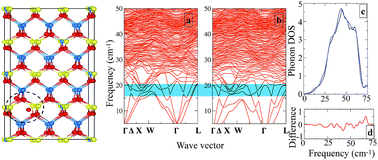Realizing high thermoelectric performance in Cu2Te alloyed Cu1.15In2.29Te4†
Abstract
Controlling the chemical and physical structure at the atomic level is of paramount importance for decreasing the thermal conductivity by enhancing phonon scattering in thermoelectric materials. Additional enhancement in the figure of merit (ZT) can be achieved by improving the electron transport properties. Cu-deficient ternary I–III–VI compounds have received increasing attention because they can easily form solid solutions and thereby their thermoelectric performance can be readily engineered. In this work, we present a novel thermoelectric compound Cu1.15In2.29Te4 with the dimensionless figure of merit ZT ∼ 1.0 through alloying with Cu2Te. The enhanced ZT value is mainly attributed to the ultralow lattice thermal conductivity (κL = 0.24 W K−1 m−1 at 825 K), caused by a pronounced local lattice disorder as a result of the interstitial residing of extra Te. Density functional theory based first-principles calculations further elucidate that the creation of the resonant states at the Fermi level and impurity levels near the valence band edge has increased the effective mass and carrier concentration, resulting in the improved electrical properties. Moreover, the localized modes of the Te interstitial defects hybridize with the acoustic modes of stoichiometric In and Te and lead to the enhanced scattering of the thermal phonons resulting in the significantly low κL. The above findings substantiate that appropriate doping of Cu2Te in the newly developed Cu1.15In2.29Te4 compound can effectively manipulate both electron and phonon transport and thereby promises high thermoelectric performance.



 Please wait while we load your content...
Please wait while we load your content...